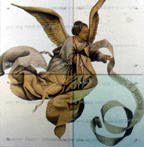Angels? Rembrandt?
Aptekar's paintings have been exhibited at the Corcoran Gallery of Art in Washington, D.C., the Victoria and Albert Museum in London, England, and the Kemper Museum in Kansas City, Missouri.
This exhibition is curated by Carla Hanzal and originated by the Contemporary Art Center of Virginia with the assistance of the Bernice Steinbaum Gallery, Miami, Florida.

12th Grade
Lesson 1: Reinterpretations of Paintings by Artists of the Past
Lesson 2
9th - 12th Grade art level ll: intermediate and art level lll: advanced intermediate
Upon completion of this unit, the students will have a better understanding about the meaning of their roles as the viewer-"spectator"- of the visual arts, as well as a better understanding of the limitations-"censorship"- put on the artist. They will be able to express how they, the students, affect the meaning of a work of art. They will do this through short discussions using an expanded art vocabulary and studio projects utilizing the media of paint, colored pencils, and type. Selected works by Ken Aptekar and images by unknown artists will be viewed and used as stylistic guides.